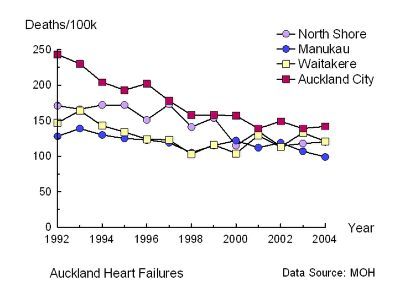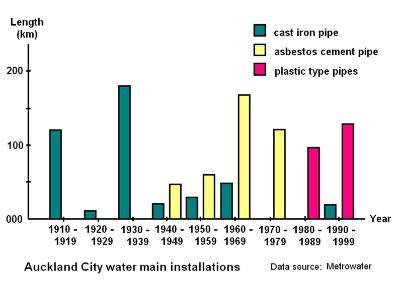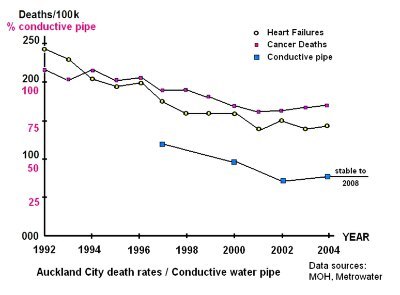
Conductive water pipe case study:
Auckland City
Auckland City is one of those rare places in New Zealand which has shown a very significant decline in both heart failure and cancer death rates over a relatively short time. From 1992 to 2004 heart failure reduced from 243/100k to 142/100k, and cancer deaths reduced from 217/100k to 172/100k: a reduction of about 40% for heart and about 20% for cancer over 12 years.
Such an astonishing decline has to beg the obvious question, why?
Background
Auckland City, for those who are unfamiliar, is part of a larger city also comprising Manukau, Waitakari and North Shore. These latter are extensions of the original city and provide a useful comparison in that they are all supplied water by the same water supply company: it is the water mains materials which are different .

Manukau and Waitakere have relatively recent water mains networks (mainly non conductive water pipes) and have relatively flat heart failure rates.
North Shore, while older, has expanded and could be considered to be somewhere between Auckland City and the newer cities in terms of the conductivity of its water mains.
Auckland City dates back to the 1800s, but much of the water main network was installed in earnest in the early 1900s.

The water pipe of choice was cast iron from 1910 to 1940, after which asbestos cement (which might be expected to have its own effect on cancer in due course!) gained popularity.
In the 1980s, the various types of plastic were favoured. So we could say that there have been three waves of pipe types, and the conductive cast iron wave is our subject.
Cast iron has an expected life of about 70 years, so replacement could be expected to have occurred from the 1980s onward. Of course, this does not necessarily mean it happened: politics being what it is, the replacement of cast iron pipe might have been deferred if leakage was still within workable limits.
Fortunately in Auckland there are asset plans every three or so years which give us a reasonable snapshot of the amount of cast iron pipe in the network over the 1992-2004 test period.
Auckland pipe replacements
The main sources of data for determining the change in cast iron pipe in the system have been asset management plans (AMPs) and the Graphic Information System (GIS). These are not terribly accurate and some corrections have had to be made. In particular, a reassessment of cast iron pipe in the 2006 AMP has been used to update previous AMPs on the basis that cast iron pipe did not materialise out of thin air. A check has been made against expenditure for each year as a guide to the total volume of pipe likely to have been replaced per annum.

Pipe data are not yet available prior to 1997 via AMPS.
The percentage of cast iron pipe has fallen from 61% (+/- 10%) in 1997 to 36% (+/- 7%) in 2002: a very significant reduction of about 40% over 5 years which is in line with the expected end-of-life replacement.
Since 2004 the amount of cast iron water main has been stable.
Importantly, this shows that the reduction in conductive water pipe, cast iron in this case, coincides with the reduction in heart failures and cancer deaths.
This further supports the hypothesis that electrically conductive water pipe affects ionisation with resultant increases in heart failure and cancer.
Therefore I am of the opinion that further research is justified and, importantly, that reticulated water should not be used for human consumption.
Stephen G Butcher (14/06/08)
Conclusion
This case study adds to the landmark trends previously identified in Japan, with the very clear and significant increase in cancer from 1950, and in Venezuela with the clear parallel increases in heart failures and cancer deaths following increased chlorination. Such trends are defined in respect to time and location, and it is appalling to think that so little research has been done, or made public, which attempts to link these effects together, to show how they relate. Perhaps this link might go some way to explaining the philosophy hampering research in this area.
If possible, I will add a further case study in similar vein if more accurate data is available: the aim would be to see if the effect of retiring conductive pipe has an immediate effect on heart failures and cancer deaths: then we could define the start of these epidemics and demonstrate the reverse - their decline, and the expected lead-in time between remedial action and epidemic reduction.


